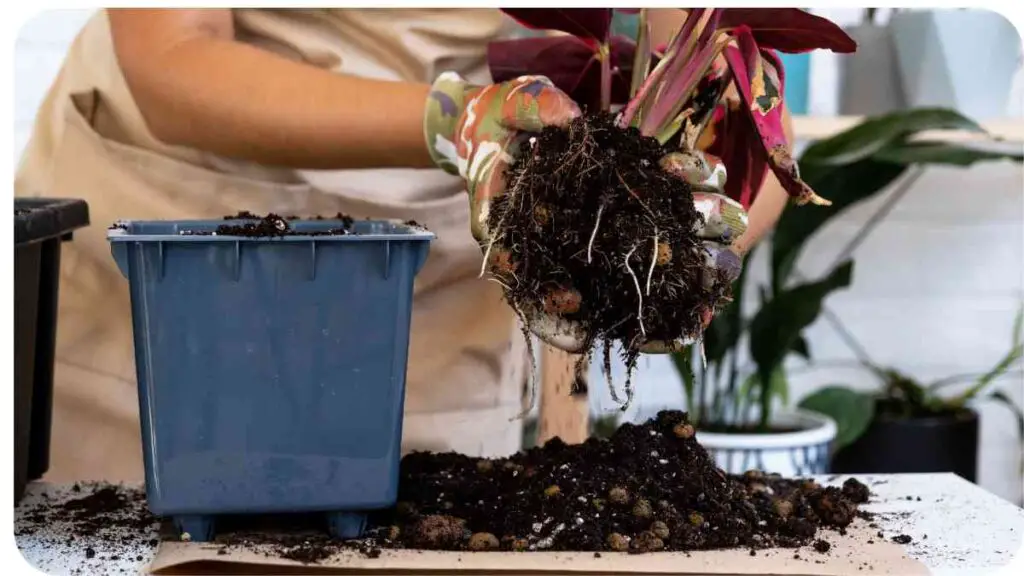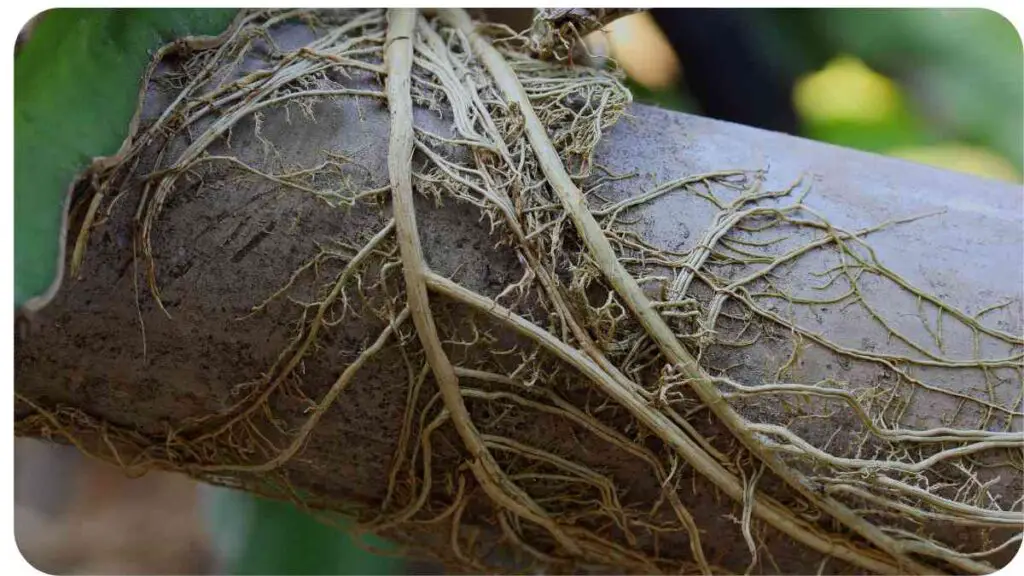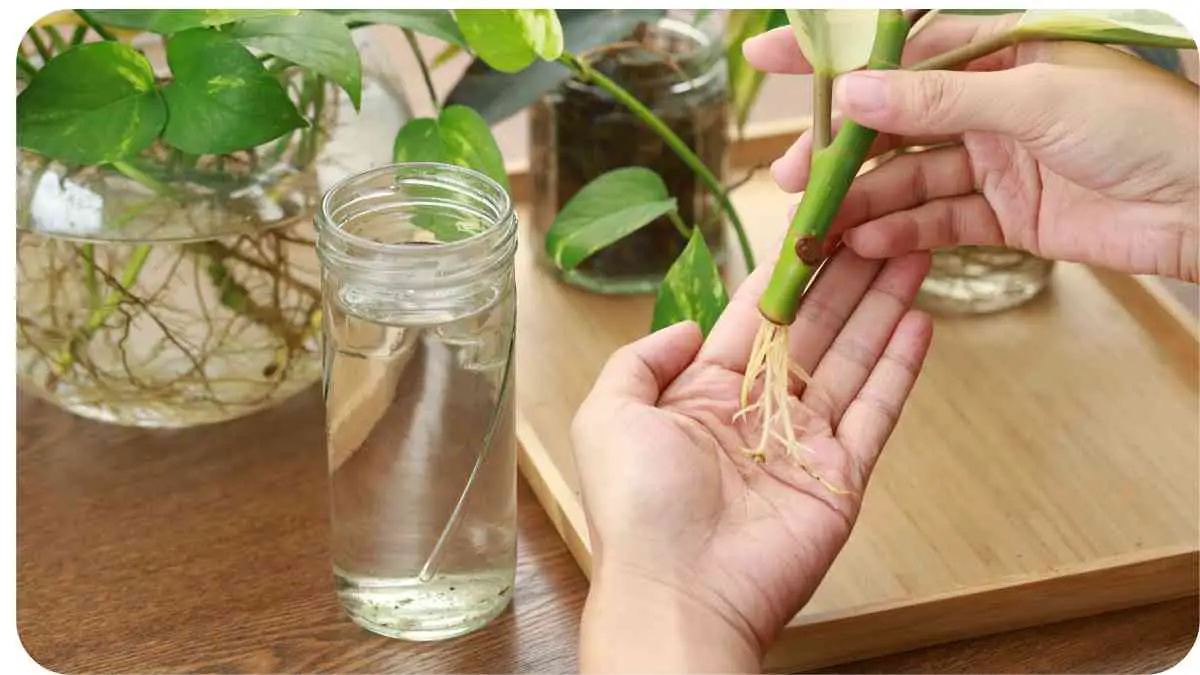If your deck plants are looking droopy and unhappy, it might not be just a case of neglect or a lack of sunlight. One common but often overlooked issue is root rot. Root rot can sneak up on even the most diligent gardeners, and it’s one of those problems that can be tricky to diagnose. It’s like a silent saboteur, quietly undermining your plants from below the surface.
Root rot is a serious condition caused by various fungi and bacteria that thrive in damp, poorly drained soil. These pathogens attack the roots, leading to a cascade of problems that can ultimately kill your plants if not addressed promptly. But don’t worry, with a bit of know-how, you can save your deck garden from this pesky issue. Let’s dive into what root rot is, how to spot it, and what you can do to prevent and treat it.
| Takeaway |
|---|
| Root rot is caused by overwatering, poor drainage, compacted soil, and infected soil. |
| Early signs of root rot include yellowing leaves, wilting, foul odor, and mushy roots. |
| Effective treatments for root rot include repotting with fresh soil, using fungicides, and adjusting watering practices. |
| Prevention strategies involve ensuring proper drainage, avoiding overwatering, and using well-draining soil. |
| Natural remedies like cinnamon, neem oil, and hydrogen peroxide can help manage root rot and improve plant health. |
What is Root Rot?
Root rot is a general term for a range of plant diseases caused by fungi and bacteria that attack the root system. These pathogens thrive in conditions where the soil is overly moist and poorly drained. Think of root rot like a cold virus: it spreads in conditions where it can easily take hold, and once it’s in, it’s hard to get rid of without proper treatment.
When roots are infected, they begin to decompose, leading to a loss of essential functions like nutrient and water uptake. This can leave your plants looking sickly and weak, no matter how much you water or fertilize them. The key to addressing root rot is understanding how it develops and recognizing the early signs.
If your deck plants suffer from poor growth or browning, it’s likely due to waterlogged soil. For helpful insights, check out how to improve drainage and avoid soggy roots by visiting soil not draining solutions for soggy garden beds to learn more.
Common Causes of Root Rot
Root rot doesn’t just happen out of nowhere; it’s usually the result of specific environmental conditions and practices. Here’s a breakdown of the main culprits:
Overwatering
Table: Effects of Overwatering
| Effect | Description |
|---|---|
| Root Suffocation | Excess water fills soil air pockets, limiting oxygen. |
| Fungal Growth | Damp conditions encourage fungi to thrive. |
| Root Decay | Roots start to rot due to prolonged moisture. |
Overwatering is probably the most common cause of root rot. When you water your plants too frequently, the soil becomes waterlogged, and the roots can’t get the oxygen they need. Imagine your plant’s roots struggling to breathe under a water blanket this is essentially what overwatering does.
Poor Drainage
Table: Drainage Issues
| Drainage Problem | Impact |
|---|---|
| Clay Soil | Retains water and doesn’t drain well. |
| Blocked Pots | Water cannot escape, causing soggy soil. |
| Improper Pot Design | Lack of drainage holes leads to waterlogging. |
Even if you’re careful about how much you water, poor drainage can still lead to root rot. If the water can’t escape from the pot or garden bed, it builds up and creates a soggy environment that’s perfect for rot-causing pathogens.
Even when you water your deck plants regularly, they might still droop and wilt. This could signal deeper problems, including root rot. Discover how to prevent this issue by reading the mystery of wilting plants despite watering, which sheds light on plant health.
Compacted Soil
Table: Compacted Soil Problems
| Issue | Consequence |
|---|---|
| Reduced Air Flow | Roots can’t get enough oxygen. |
| Poor Water Infiltration | Water pools on the surface, leading to rot. |
| Root Growth Restriction | Roots can’t expand properly. |
Soil that’s too compacted doesn’t allow water to flow through it properly. This leads to waterlogging and creates an ideal environment for root rot. Imagine trying to push a needle through a dense block of clay—compacted soil restricts root growth in a similar way.
Infected Soil
Table: Sources of Soil Infection
| Infection Source | How It Spreads |
|---|---|
| Contaminated Soil | Soil can harbor pathogens that infect plants. |
| Reusing Old Soil | Fungi and bacteria can survive in old soil. |
| Unsterilized Pots | Pots that haven’t been cleaned properly can spread pathogens. |
Soil that’s already infected with rot-causing fungi or bacteria can pass these pathogens onto your plants. This can happen if you reuse old soil without proper treatment or if you plant in pots that weren’t cleaned thoroughly.
Signs of Root Rot

Recognizing the signs of root rot early can save your plants. Here are the key indicators:
Yellowing Leaves
Table: Causes of Yellowing Leaves
| Cause | Description |
|---|---|
| Nutrient Deficiency | Roots can’t absorb nutrients properly. |
| Overwatering | Too much water can cause leaves to yellow. |
| Disease | Yellowing can be a sign of root infection. |
Yellowing leaves are often the first visible sign that something’s wrong with your plant. This can happen when the roots are too damaged to take up nutrients, or when the plant is stressed due to overwatering.
Wilting
Table: Wilting Causes
| Cause | Description |
|---|---|
| Root Damage | Infected roots can’t support the plant. |
| Lack of Water | Despite overwatering, wilting can occur. |
| Root Compaction | Roots are unable to absorb enough moisture. |
Wilting can be a sign that the plant isn’t getting enough water, but it can also be due to root rot. Even if the soil is wet, the damaged roots may not be able to transport water effectively.
When deck plants start to show yellowing leaves, it’s often a red flag for root damage or disease. Learn more about this common symptom and its potential causes by visiting solving the mystery of yellowing leaves, which provides crucial plant care tips.
Foul Odor
Table: Odor Sources
| Source | Description |
|---|---|
| Decaying Roots | Rotting roots emit a bad smell. |
| Stagnant Water | Standing water can smell unpleasant. |
| Mold Growth | Mold and mildew contribute to foul odors. |
A foul odor coming from the soil is a red flag that rot is present. This smell is often a result of decaying roots and mold growth.
Mushy Roots
Table: Root Texture Issues
| Issue | Description |
|---|---|
| Soft Roots | Healthy roots should be firm. |
| Discoloration | Rotting roots may appear dark or slimy. |
| Root Decay | A mushy texture indicates severe rot. |
Mushy, discolored roots are a clear sign of advanced root rot. Healthy roots are usually firm and white or light-colored.
Preventing Root Rot
Preventing root rot is all about creating the right conditions for your plants and maintaining good practices. Here’s what you can do:
Proper Watering Techniques
Table: Watering Tips
| Tip | Description |
|---|---|
| Water When Needed | Only water when the soil is dry to the touch. |
| Use Well-Draining Soil | Choose soil that drains well. |
| Avoid Waterlogging | Ensure excess water can escape from the pot. |
Watering correctly is crucial. Rather than sticking to a strict schedule, check the soil moisture level and water only when necessary. This helps prevent the soil from becoming waterlogged.
Fungal infections are a frequent cause of root rot in deck plants. To effectively manage this and keep your plants healthy, check out strategies for combatting common fungal diseases in trees, which offers solutions for fungal-related plant issues.
Choosing the Right Soil
Table: Soil Types
| Soil Type | Characteristics |
|---|---|
| Sandy Soil | Drains well but may need additional nutrients. |
| Loamy Soil | Well-balanced and ideal for most plants. |
| Clay Soil | Holds moisture but can lead to poor drainage. |
Selecting soil that drains well is essential for preventing root rot. Loamy soil is generally the best choice as it provides a good balance of drainage and moisture retention.
Improving Drainage
Table: Drainage Solutions
| Solution | Description |
|---|---|
| Add Drainage Holes | Ensure pots have adequate drainage holes. |
| Use Gravel or Perlite | Mix into soil to improve drainage. |
| Elevate Pots | Raise pots slightly to allow excess water to drain away. |
| Avoid Saucers | If using saucers, ensure they are not filled with water. |
Improving drainage can make a huge difference. For potted plants, make sure your pots have enough drainage holes to let excess water escape. Adding materials like gravel or perlite to your soil mix can also help improve drainage and prevent water from pooling around the roots. Elevating your pots slightly or avoiding saucers can further help with excess water management.
Regular Maintenance
Table: Maintenance Tips
| Task | Frequency | Description |
|---|---|---|
| Check Soil Moisture | Weekly | Use a moisture meter or finger test. |
| Inspect Pots | Monthly | Look for signs of clogging or damage. |
| Clean Tools | After Use | Sterilize gardening tools to prevent soil-borne diseases. |
| Prune Affected Areas | As Needed | Remove any dead or diseased plant parts. |
Regular maintenance can help catch potential problems before they become serious. Checking soil moisture regularly ensures you’re not overwatering, while inspecting pots and cleaning tools helps prevent the spread of disease. Pruning affected areas can also help reduce stress on the plant and promote healthier growth.
Excess moisture not only leads to root rot in plants but can also encourage algae growth. If this sounds familiar, explore more about moisture control and algae management by visiting why your garden water feature keeps blooming algae, which dives into related water and plant issues.
Treating Root Rot

When root rot strikes, prompt action is crucial to save your plants. Here are some effective treatments:
Repotting
Table: Repotting Steps
| Step | Description |
|---|---|
| Remove Plant | Gently take the plant out of its pot. |
| Inspect and Clean Roots | Remove affected roots and clean with water. |
| Prepare Fresh Soil | Use fresh, well-draining soil. |
| Replant and Water Light | Replant the plant and water lightly to avoid overwatering. |
Repotting is often the best way to address root rot. Start by carefully removing the plant from its pot and inspecting the roots. Cut away any rotting or mushy roots, and then repot the plant in fresh, well-draining soil. Water the plant lightly and keep it in a well-ventilated area to help it recover.
Using Fungicides
Table: Fungicide Options
| Fungicide | Application Method | Description |
|---|---|---|
| Copper-Based | Spray or soil application | Effective against a range of fungal pathogens. |
| Systemic Fungicides | Soil treatment or foliar spray | Absorbed by plant to combat systemic infections. |
| Biological Fungicides | Soil application | Uses natural organisms to combat root rot. |
Fungicides can help manage and eliminate fungal infections causing root rot. Copper-based fungicides are commonly used and effective against various fungal pathogens. Systemic fungicides are absorbed by the plant and can be helpful for severe cases. Biological fungicides use natural organisms to combat rot and are a good eco-friendly option.
Adjusting Watering Schedule
Table: Watering Adjustments
| Adjustment | Description |
|---|---|
| Reduce Frequency | Water less frequently to prevent overwatering. |
| Check Moisture Levels | Adjust watering based on actual soil moisture. |
| Use a Drip System | Provides consistent moisture without overwatering. |
Adjusting your watering schedule is key to treating root rot. By reducing the frequency of watering and checking soil moisture levels regularly, you can avoid creating conditions that favor root rot. Consider using a drip irrigation system to provide consistent moisture without overwatering.
Alternative Solutions
For those looking for different approaches, here are some alternative solutions to consider:
Natural Remedies
Table: Natural Remedies
| Remedy | Description |
|---|---|
| Cinnamon | Acts as a natural fungicide. |
| Neem Oil | Has antifungal properties and repels pests. |
| Hydrogen Peroxide | Helps oxygenate the soil and kill pathogens. |
Natural remedies can be effective in managing root rot. Cinnamon is a natural fungicide that can be sprinkled on the soil to help combat fungal infections. Neem oil is another option that not only helps with fungal issues but also repels pests. Hydrogen peroxide can help oxygenate the soil and kill pathogens without harming your plant.
Professional Help
Table: Professional Services
| Service | Description |
|---|---|
| Garden Centers | Can offer advice and treatments. |
| Plant Specialists | Provide expert diagnosis and treatment plans. |
| Soil Testing Labs | Analyze soil conditions and recommend solutions. |
If you’re struggling with root rot and the treatments aren’t working, seeking professional help might be the best course of action. Garden centers and plant specialists can provide advice and treatments tailored to your specific problem. Soil testing labs can analyze your soil conditions and offer recommendations for improving soil health and preventing future issues.
Real-Life Success Stories
Sometimes, hearing about others’ experiences can provide valuable insights and inspiration. Here are a couple of real-life success stories of gardeners who successfully tackled root rot:
Case Study 1
Table: Case Study 1
| Name | Problem | Solution | Outcome |
|---|---|---|---|
| Sarah T. | Overwatered deck plants with yellowing leaves | Repotted plants with fresh soil and improved drainage | Plants recovered and thrived. |
Sarah T. faced a severe case of root rot due to overwatering and poor drainage. By repotting her plants into fresh soil and enhancing drainage, she was able to restore their health. The plants began to recover, showing vibrant green leaves and strong growth.
Case Study 2
Table: Case Study 2
| Name | Problem | Solution | Outcome |
|---|---|---|---|
| John M. | Root rot in container garden | Used fungicides and adjusted watering schedule | Successfully eliminated rot and improved plant health. |
John M. dealt with root rot in his container garden. He applied fungicides and adjusted his watering schedule to prevent overwatering. The result was a significant improvement in plant health and a reduction in rot symptoms.
Conclusion
Root rot can be a frustrating issue, but with the right knowledge and practices, you can prevent and treat it effectively. By understanding the causes, recognizing the signs, and applying the appropriate treatments, you can help your deck plants thrive and avoid the problems that come with root rot.
FAQs
1. How can I tell if my plant has root rot?
Look for yellowing leaves, wilting, a foul odor from the soil, and mushy roots. These are common signs of root rot.
2. Can root rot be treated?
Yes, root rot can be treated by repotting the plant, using fungicides, and adjusting watering practices. Early intervention is key.
3. What’s the best way to prevent root rot?
Prevent root rot by ensuring proper drainage, avoiding overwatering, and using well-draining soil. Regular maintenance and monitoring can also help.
4. Can I use natural remedies for root rot?
Yes, natural remedies like cinnamon, neem oil, and hydrogen peroxide can be effective in managing root rot and improving plant health.
5. When should I seek professional help for root rot?
If root rot persists despite your efforts or if you’re unsure of the best treatment, seeking professional advice from garden centers or plant specialists can be beneficial.4o mini
Further Reading
Understanding and Preventing Plant Root Rot
An insightful blog that explains the causes of plant root rot and offers practical tips for prevention and treatment.
Root Rot Solutions and Prevention
A comprehensive guide detailing effective methods to manage and prevent root rot, with a focus on natural and organic solutions.
How to Get Rid of Root Rot
A detailed resource on identifying root rot and the steps to take to eliminate it, including treatment options and best practices.
FAQs
What are the main causes of root rot?
Root rot is primarily caused by overwatering, poor drainage, compacted soil, and infected soil. These conditions create a damp environment that promotes the growth of rot-causing fungi and bacteria.
How can I identify root rot in my plants?
Look for signs such as yellowing leaves, wilting despite moist soil, a foul odor from the soil, and mushy or discolored roots. These indicators suggest that root rot might be affecting your plants.
Can root rot be treated successfully?
Yes, root rot can be treated successfully by repotting the plant into fresh, well-draining soil, using fungicides, and adjusting your watering practices to avoid waterlogging.
How can I prevent root rot from occurring?
Prevent root rot by ensuring proper drainage in pots and garden beds, avoiding overwatering, using well-draining soil, and maintaining regular garden maintenance.
Are there natural remedies for root rot?
Yes, natural remedies such as cinnamon, neem oil, and hydrogen peroxide can be effective in managing root rot. These solutions help combat fungal infections and improve soil health.

Hi! My name is Hellen James, and I’m a landscape designer in Los Angeles. I’ve been working with homeowners and businesses to help them improve the look of their properties for over 10 years.

